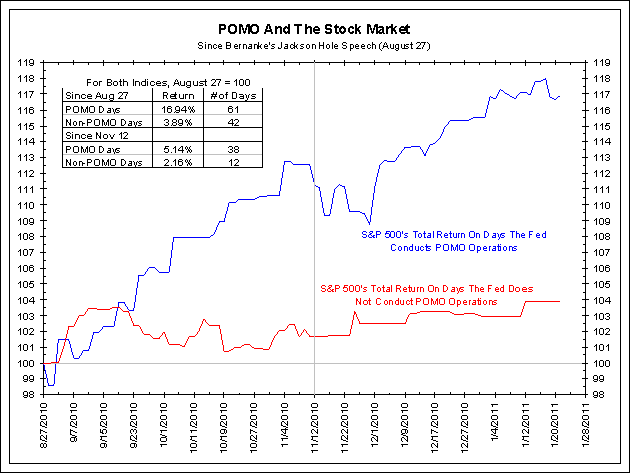- Greenlight Capital – Partner Letter, January 18, 2011
On August 27, 2010, Federal Reserve Bank Chairman Ben Bernanke gave a speech in Jackson Hole, Wyoming where he hinted that the Fed would provide additional monetary easing. At the time, the S&P 500 was down more than 3% for the year. From that point through the end of the year, the S&P rallied 19%. At the same time, oil prices rose 16%, copper prices rose 32%, coffee prices rose 34%, corn prices rose 43% and cotton prices rose 57%. In front of Congress, Mr. Bernanke credited his policies for “significant improvements in stock prices” which are “contributing to a better outlook for the economy.” Mr. Bernanke also said his policies are not to blame for the sharp increase in the price of oil, which he claimed is the result of strong demand from emerging markets. Does Mr. Bernanke really believe anyone buys that? Ostensibly, it’s a coincidence that many of the necessities of life came into simultaneous shortage and shot up in price just as Mr. Bernanke promised
additional monetary stimulus. Mr. Bernanke told the news show “60 Minutes” that he was “100% certain” that the Fed could control inflation should it become a problem. As for the future, we are 100% certain of nothing. The good news is that our job is not to know the future, but rather to understand that it is uncertain and to construct a portfolio that should generate attractive results under a wide variety of outcomes. That may mean achieving lower (but still acceptable) returns than long-only stock indices when they travel straight north. This is what happened during the fourth quarter of 2010. - The Big Picture (blog) – How Much Has the Fed Distorted the Stock Market?
How much of this is attributable to the Fed? Its only a guess, but if merely half of the markets excess gains (over the past rallies) are attributable to the Fed,it means that the US Central Bank has artificially created several trillion dollars in market capitalization. The end game of this, and the unintended consequences, are beyond my ability to guess . . . - Barron’s – Michael Santoli: A Well-Timed Dip
The other test is being administered to the growing and increasingly vocal crowd insisting that the low-volume, low-volatility sleepwalk to new bull-market highs is evidence of a market rigged by the Federal Reserve and not allowed to decline meaningfully, with every intra-day dip rescued by what even a technical analyst quoted by The Wall Street Journal Tuesday called a “mysterious force.” Well, sure, the Fed wants to see equity markets move higher. All post-recession, ultra-easy Fed regimes in history have desired, if not engineered, rising stock prices. The main difference with the Bernanke Fed is that the chairman is honest about it, having cited higher stock prices both in an op-ed article and this month in a talk at the FDIC as one barometer of the success of its “quantitative easing” campaign. The phrase “Don’t fight the Fed” is decades old, let’s recall, which doesn’t mean it has always been a great investing guide. The more interesting question is whether the investment community came into this year so convinced that the Fed and assorted other actors somehow wouldn’t let stocks drop meaningfully that the market’s knack for confounding group expectations means just that might happen.
Comment

Let’s call this what it is, a bubble. Even Bernanke described it as such in his November 4 Washington Post op-ed:
And higher stock prices will boost consumer wealth and help increase confidence, which can also spur spending. Increased spending will lead to higher incomes and profits that, in a virtuous circle, will further support economic expansion.
Bernanke’s “virtuous stock market cycle”can also be described as a stock market bubble. To be clear, manipulating stock prices higher in hopes that stock prices alone will change beliefs (confidence) and behavior (spending) is a bubble. Bernanke did not say he is trying to ramp the economy higher and that will support higher valuations. This would not be a bubble.
That said, because we call it a bubble does not mean this is similar to March 2000 in tech stocks or 2006 in housing. The bubble is not nearly that big. But, with the Federal Reserve still printing hundreds of billions more for several more months, it still has room to grow.
How does this work? We discussed the Federal Reserve’s effect on stocks prices in our conference call earlier this month (Handout Audio Webcast).
The Federal Reserve believes in the portfolio balance theory. This means it does not matter what they buy with newly printed money (QE2). The market will arbitrage this new money into the market that it thinks it will have the most impact. So do not get hung up on what the Federal Reserve is buying, but rather think about where these new dollars matter the most.
Right now the markets think that newly printed dollars will benfit “risk on” markets like stocks. So, Treasury purchases are a conduit to the “risk on” markets. Treasuries will still respond to the ups and downs of the economy like they always do. Stocks, on the other hand, respond to the perceptions of newly printed dollars from the Federal Reserve and other larger macro themes (like fear or relief of a double dip recession) than the more traditional fundamentals.